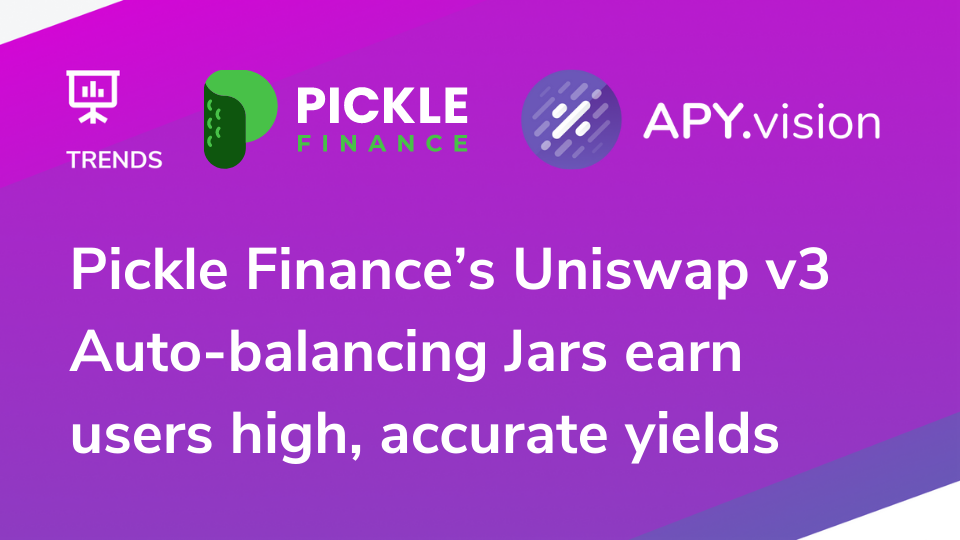Pickle Finance’s Uniswap v3 Auto-balancing Jars earn users high, accurate yields

In this post we share details on the new Pickle Finance Uniswap v3 jars for earning yield.

What is Pickle Finance?
Pickle Finance is a yield aggregator that provides users with the ability to auto-compound their LP positions across (as of writing) 11 different chains. Some of these auto-compounding “Jars” also distribute Pickle Finance’s native token “PICKLE,” further boosting users’ rewards. PICKLE can also be locked to earn DILL, which provides holders 45% of the protocol’s revenue, paid out weekly. After a recent PIP (Pickle Improvement Proposal) DILL holders will get 100% of protocol revenues in WETH.
What are Pickle Finance’s Uniswap v3 Jars?
Pickle Finance at the start of the year launched their Uniswap v3 auto-balancing yield farming strategies. These strategies allow farmers to realize the higher fees that Uni v3 capital efficient pools provide, while also ensuring users never lose their trading fees if a price falls out of range.
Currently Pickle Finance have Uni v3 Jars on Ethereum Mainnet and Polygon, with plans to expand to other chains that Uniswap provides v3 LP positions for.
How do these Jars work under the hood?
On deposit into a Pickle Finance v3 Jar, your deposit is swapped for the correct ratio of tokens. The Pickle Jar then collects trading fees earned and redeposits them, compounding your earnings.
If the price of the underlying assets move out of the assigned capital efficient range, Chainlink Keepers activate the Jar to automatically rebalance the position to help ensure that Jars always remain in range and collect fees! What does this mean? Normally, when users deposit into a Uniswap v3 Pool, they are allowed to set a minimum and maximum price to provide liquidity for. Providing a narrower range increases the amount of fees earned, but also means when the current price is out of range they will stop earning fees. The Pickle Finance Jars keep users in range by rebalancing the min and max price range to give assurance that higher fees are always being earned.
High, accurate yield

At APY Vision, we have run the numbers and can confirm that on-chain data accurately reflects the stated APY on the Pickle Finance site. We compiled on-chain returns over time to better understand the actual returns users get in these v3 Jars. We found that for the most part the APYs are accurate, and users are getting the high yield stated within a few percentage points.
Utilising Uniswap v3 legos
With many DeFi protocols utilising Uni v3 LP positions to create liquidity for their native tokens, Pickle Finance spotted an opportunity to utilise their Uni v3 Jars as DeFi legos in building out new and differentiated products.
Recently they released a “Frax Brinery” which acts like a backscratcher for the Frax ecosystem. This Brinery takes advantage of the flywheel effects of locking FXS for veFXS, allowing users to easily enter and exit the Frax veFXS vaults with the redeemable pveFXS, earning higher FXS rewards than if they’d staked themselves.
Furthermore, 10% of the FXS Rewards from the Uni v3 FRAX/USDC and FRAX/DAI Jars are directed to those that locked pveFXS in the Brinery. Users also save gas as Pickle Finance continuously extend the veFXS lock.

The path to DeFi innovation at Pickle Finance
These Uni v3 Jars are just one innovation that Pickle Finance are going to be launching this year, with their roadmap for 2022 being very ambitious.

At APY Vision we’re excited to see the innovation coming from the Pickle Finance team. There are exciting future plans in place including more Uni v3 jars on Pickle Finance’s strategy roster, an expansion of the Brinery ecosystem and a potential stablecoin called $GREEN.
Stay Connected with Pickle Finance
Learn more about Pickle Finance by visiting pickle.finance, joining their Discord and following them on Twitter.
APY.Vision does not give investment advice and always insists that you do your own research. Read our full Legal Disclaimer.
Check out APY.Vision!
APY.Vision is an advanced analytics tool for liquidity pool providers and yield farmers. If you’re using any DEXs, AMMs, or liquidity pools this is the tool you will need to easily track the ROI of your liquidity provider and yield farming activities. Try it now!
